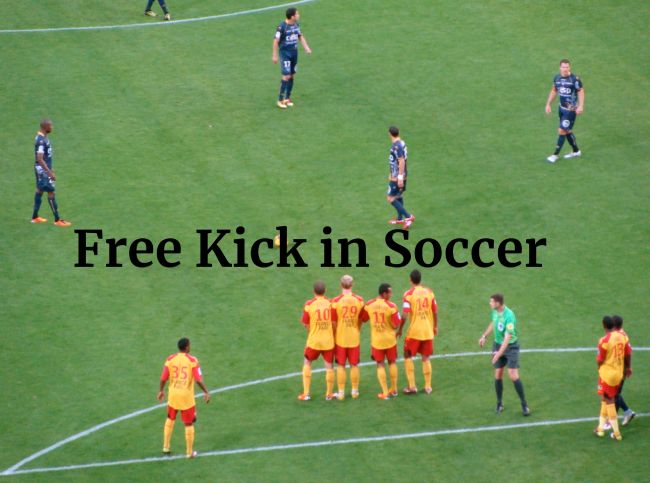Free kick in soccer are an integral part, and they can have a significant impact on the outcome of a match. A free kick is awarded to a team when an opposing player commits a foul.
This article will cover everything you need to know about free kicks in soccer, including how they work, the different types of free kicks, and how to take a free kick.
Table of Contents
How do free kicks work?
When a foul is committed in soccer, the referee will blow the whistle and award a free kick to the opposing team. The free kick can be taken from the spot where the foul was committed, or from a designated spot if the foul was committed outside the penalty area. The opposing team must be at least ten yards away from the ball when the free kick is taken.
There are two types of free kicks in soccer: direct and indirect. A direct free kick can be taken straight at the goal, while an indirect free kick requires another player to touch the ball before it can go into the goal.

Different types of free kicks
There are several different types of free kicks in soccer. The most common types include:
- Curling free kick: This is a technique where the ball is kicked with a curved trajectory, making it harder for the goalkeeper to catch.
- Power free kick: This type of free kick is taken with a lot of force, making it difficult for the goalkeeper to save.
- Lofted free kick: This type of free kick is taken with a lot of height, allowing the ball to dip down towards the goal.
- Short free kick: This is when the ball is passed to a teammate instead of being shot directly at the goal.
How to take a free kick?
Taking a free kick requires skill and practice. Here are some tips to help you take the perfect free kick:
- Decide on your strategy: Before taking the free kick, decide on your strategy. Are you going to shoot straight at the goal, or are you going to pass to a teammate?
- Approach the ball: Approach the ball from an angle, and take three to four steps back.
- Plant your non-kicking foot: Plant your non-kicking foot beside the ball, and point it towards the target.
- Strike the ball: Strike the ball with the inside or outside of your foot, depending on the trajectory you want to achieve. Remember to keep your head down and your eyes on the ball.
- Follow through: Follow through with your kicking foot, and aim for the target.
Rules of Free Kicks in Soccer
Free kicks are awarded to a team when an opposing player commits a foul. The location of the free kick depends on where the foul was committed. If the foul was committed within the penalty area, the free kick is taken from the penalty spot. If the foul was committed outside the penalty area, the free kick is taken from the spot where the foul was committed or from a designated spot.
The opposing team must be at least ten yards away from the ball when the free kick is taken. If a player on the opposing team enters the penalty area before the free kick is taken, the free kick is retaken.
There are two types of free kicks in soccer: direct and indirect. A direct free kick can be taken straight at the goal, while an indirect free kick requires another player to touch the ball before it can go into the goal. An indirect free kick is awarded for non-contact fouls, such as dangerous play, obstruction, or offside.
Techniques for Taking Free Kicks in Soccer
Taking a free kick requires skill, technique, and practice. Here are some tips for taking the perfect free kick:
- Choose your strategy: Before taking the free kick, decide on your strategy. Are you going to shoot straight at the goal, or are you going to pass to a teammate? Look at the positioning of the opposing team’s defenders and goalkeeper to determine the best strategy.
- Approach the ball: Approach the ball from an angle, and take three to four steps back. This gives you enough space to generate power and momentum for the kick.
- Plant your non-kicking foot: Plant your non-kicking foot beside the ball, and point it towards the target. This helps to maintain balance and control during the kick.
- Strike the ball: Strike the ball with the inside or outside of your foot, depending on the trajectory you want to achieve. Keep your head down and your eyes on the ball throughout the kick.
Famous Examples of Free Kicks in Soccer
Free kicks have produced some of the most memorable moments in the history of soccer. Here are some famous examples of free kicks:
- David Beckham vs Greece: In a crucial World Cup qualifying match in 2001, David Beckham scored a stunning free kick in the 93rd minute to secure England’s place in the tournament.
- Juninho Pernambucano vs Barcelona: In a Champions League match in 2009, Juninho Pernambucano scored two free kicks against Barcelona, one of the best teams in the world at the time.
- Roberto Carlos vs France: In a friendly match in 1997, Roberto Carlos scored a free kick from an impossible angle, bending the ball around the French wall and into the goal.
Conclusion
Free kicks are an important part of soccer, and they require skill and practice to master. Understanding the different types of free kicks and how to take them can help you improve your game and increase your chances of scoring goals. Remember to stay focused, keep your eyes on the ball, and practice regularly to become a free kick expert.
